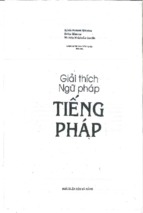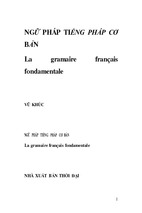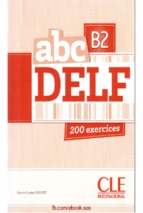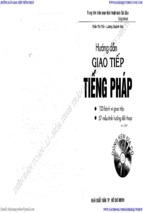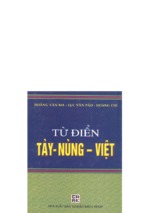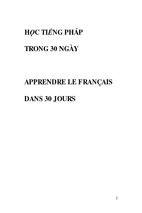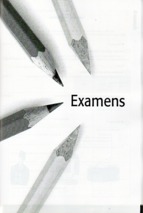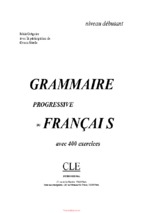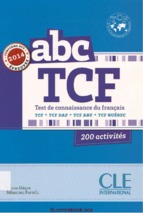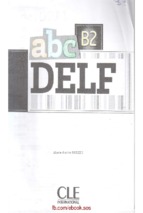fb.com/ebook.sos
ebooksos.blogspot.com
Speed Up Your French
Speed Up Your French is a unique and innovative resource that identifies and
explains the errors most commonly made by students of French.
From false friends to idiomatic expressions and the use of prepositions, each of
the nine chapters focuses on an aspect of the language where English speakers
typically make mistakes. Full explanations are provided throughout with clear,
comprehensive examples, enabling students to acquire a surer grasp of French
vocabulary and idiom, as well as grammar.
Key features:
•
•
•
•
carefully selected grammar topics and examples based on the most
commonly made errors
extensive exercises and answer key to reinforce learning, link theory to
practice and promote self-study
use of mnemonic devices, including illustrations, to aid understanding
supplementary exercises and answer key available at www.routledge.com/
cw/jubb.
Suitable for either classroom use or self-study, Speed Up Your French is the ideal
resource for all intermediate learners of French wishing to refine their language
skills.
Margaret Jubb is Honorary Senior Lecturer in French at the University of
Aberdeen.
Speed Up Your Language Skills
SERIES EDITOR: Javier Muñoz-Basols, University of Oxford, UK
The Speed Up Your Language Skills series publishes innovative, high-quality
textbooks focusing on common errors as an effective tool to improve one’s skills
in a foreign language. Such errors are often either driven by linguistic transfer from
English or caused by common misperceptions about the grammatical structure
of a foreign language.
The primary objectives of the series are to explain and illustrate in context the most
common errors made by English-speaking students in a foreign language and to
classify them in easy-to-reference categories. Students can thus learn the
appropriate usage of words and expressions and understand the reasons why they
persistently make the same mistakes. The inclusion of exercises, shortcuts,
mnemonic devices and much-needed strategies, not usually seen in conventional
grammar books, facilitates vocabulary acquisition and mastery of essential
grammatical elements.
Books in the series are intended as primary or supplementary texts at the
intermediate and advanced levels. Due to its self-explanatory approach and userfriendly format, the series is also recommended for self-learners who wish to ‘speed
up’ their language skills.
Available titles in the series:
Speed up your Arabic
Sebastian Maisel
Speed up your Chinese
Shin Yong Robson
Speed up your French
Margaret Jubb
Speed up your Korean
Lucien Brown and Jaehoon Yeon
Speed up your Spanish
Javier Muñoz-Basols, Marianne David and Olga Núñez Piñeiro
Speed Up Your French
Strategies to avoid common errors
Margaret Jubb
First published 2016
by Routledge
2 Park Square, Milton Park, Abingdon, Oxon OX14 4RN
and by Routledge
711 Third Avenue, New York, NY 10017
Routledge is an imprint of the Taylor & Francis Group, an informa business
© 2016 Margaret Jubb
The right of Margaret Jubb to be identified as author of this work has
been asserted by her in accordance with sections 77 and 78 of the
Copyright, Designs and Patents Act 1988.
All rights reserved. No part of this book may be reprinted or
reproduced or utilised in any form or by any electronic, mechanical, or
other means, now known or hereafter invented, including photocopying
and recording, or in any information storage or retrieval system, without
permission in writing from the publishers.
Trademark notice: Product or corporate names may be trademarks or
registered trademarks, and are used only for identification and
explanation without intent to infringe.
British Library Cataloguing-in-Publication Data
A catalogue record for this book is available from the British Library
Library of Congress Cataloging-in-Publication Data
Names: Jubb, Margaret A.
Title: Speed up your French : strategies to avoid common errors /
Margaret Jubb.
Description: Milton Park, Abingdon, Oxon ; New York, NY : Routledge, [2016] |
Series: Speed up your Language Skills | Includes bibliographical references
and index.
Identifiers: LCCN 2015035056| ISBN 9781138849990 (hardback : alk. paper) |
ISBN 9781138850002 (pbk. : alk. paper) | ISBN 9781315725062 (ebook)
Subjects: LCSH: French language—Grammar—Problems, exercises, etc. |
French language--Errors in usage. | French language—Textbooks for foreign
speakers—English.
Classification: LCC PC2460 .J83 2016 | DDC 448.2/421—dc23
LC record available at http://lccn.loc.gov/2015035056
ISBN: 978-1-138-84999-0 (hbk)
ISBN: 978-1-138-85000-2 (pbk)
ISBN: 978-1-315-72506-2 (ebk)
Typeset in Swiss 721 and Zapf Calligraphic
by Florence Production Ltd, Stoodleigh, Devon, UK
Additional materials are available on the companion website at www.routledge.com/cw/jubb
Contents
Introduction
vii
1
Gender and number
1
2
Mastering false friends: verbs
34
3
Mastering false friends: nouns
53
4
Mastering false friends: adjectives and adverbs
90
5
Common verb phrases and idiomatic expressions
110
6
Pronominal verbs
137
7
Problem pairs and other misused expressions
160
8
Use of prepositions
187
9
Spelling and more
215
Appendix 1: Use of prepositions with names of countries
and islands
Appendix 2: Answer key to exercises
Bibliography
Index
230
235
245
247
This page intentionally left blank
Introduction
This book is intended for English-speaking students, either at secondary school
or at university, who have attained an intermediate level in French. It is designed
primarily as a guide for self-learning, though it could also be used as a supplement
to classroom materials, both for intermediate-level students and for more advanced
students who need to revise particular areas of the language.
It focuses on the aspects of foreign language, such as false friends, idiomatic
expressions, and the use of prepositions that typically cause English speakers
difficulty in their production and understanding of French. The aim is to enable
students to identify, understand and overcome their errors in order to become more
competent and confident language users with a surer grasp of vocabulary and
idiom, as well as grammar.
The illustrative examples that accompany the sections of explanation are as
important as the explanations themselves in encouraging students to break old
connections based on false analogies with English and form new connections and
associations with other related French expressions. Students will develop their own
learning strategies through active engagement with the material in the book, but
at particular points mnemonic devices are suggested, both for immediate support
and in the hope that they will encourage the creation of other self-tailored devices.
Throughout the book, it is emphasised that the examples given can rarely be
exhaustive, and students are advised, when appropriate, to consult a good
bilingual dictionary or a reference grammar to further their independent learning.
Active learning is promoted by the extensive exercises and answer key for selfchecking. In each chapter, the final exercise takes the form of a continuous text
with gaps to be filled. Unlike the earlier sentence-based exercises, each of which
relates to a particular section or sections of a chapter, this final exercise covers
the whole chapter and serves as a revision tool.
It would be impossible to cover in a single book every type of common error,
so a selection has necessarily had to be made. The author has deliberately decided
viii
Speed Up Your French
not to write a revision grammar, but rather to follow the precedent set by the
Spanish volume in the Speed Up Your Language series with a focus on vocabulary
and idiom as much as on grammar. This book brings together a variety of material,
accompanied by exercises, that is not readily available elsewhere in such a
systematised form. We hope that it will enable students to improve their mastery
of French not only by avoiding common errors but also by acquiring a deeper
understanding of the language and a richer range of expression.
Chapter 1 deals with the gender and number of simple and compound nouns
in French. The first part underlines how important it is for students to learn the
gender of nouns so they can improve the accuracy of their spoken and written
French. A list of general patterns helps to predict the gender of a noun, in some
cases according to meaning, but more often according to ending. Notable
exceptions are highlighted and attention is drawn to common problem nouns.
Some subtleties of the language are then explored by discussing nouns that
change meaning according to gender, e.g. un crème (a white coffee) as opposed
to la crème (cream), or whose gender varies according to use, e.g. tous les braves
gens (m.), but toutes les vieilles gens (f.). The second part of the chapter focuses
on the formation of the plural of simple and compound nouns in French. It then
highlights differences between the two languages in their treatment of the plural,
discussing cases where a plural in French corresponds to a singular in English
and vice versa. The final section of the chapter tackles common problems with
adjective agreements, which arise as soon as matters of gender and number are
considered.
Chapters 2, 3 and 4, though they deal respectively with verbs, nouns, and
adjectives and adverbs, all focus on the phenomenon of ‘false friends’, which are
a common cause of error for English-speaking students. These words look like
English words, but they have a different meaning. In each chapter, there are
two lists, the first consisting of ‘false friends’ proper and the second of words
whose meaning overlaps partially with the assumed English equivalent. Example
sentences are chosen to illustrate the meaning of the words in context and useful
phrases are given to help fix them in the memory. Related words and synonyms
are discussed, all with the aim of expanding students’ vocabulary and accuracy
of usage.
Chapter 5 deals with common phrases and idiomatic expressions used with
the verbs aller, avoir, donner, être, faire, mettre, prendre, tenir, tomber and venir.
If students are not aware of the variety of ways in which these verbs are used and
how often their meaning is not a literal one, e.g. venir de faire quelque chose (to
have just done something), common errors of misunderstanding may arise. This
chapter encourages students to add these expressions to their active, as well as
their passive, vocabulary.
Chapter 6 highlights pronominal verbs like se débrouiller (to manage). Englishspeaking students of French are sometimes surprised by the frequency with which
Introduction
ix
these verbs occur when there is no reflexive or reciprocal meaning at issue. This
chapter explains how and why they are used, and distinguishes between the
pronominal and non-pronominal usage of verbs like améliorer/s’améliorer (to
improve). It also discusses the use of a pronominal verb to translate an English
passive and the distinction, often problematic for an English speaker, between
action and state, as in elle s’assied (she sits down) and elle est assise (she is
sitting).
Chapter 7 examines so-called problem pairs and other misused expressions.
The problems discussed in the first part of the chapter arise from pairs or groups
of French words that students sometimes find it difficult to choose between. These
include: verbs such as savoir and connaître; nouns such as le parti, la partie, and
la part; the pronouns y and en; and the adjective meilleur and the adverb mieux
for ‘better/best’. The next section of the chapter considers common French
expressions that have more than one meaning, e.g. arriver (to arrive or to happen).
The chapter concludes by highlighting some common French expressions that
are sometimes misused, e.g. il s’agit de (it is a question of; it is about) or
misunderstood, e.g. tu me manques (I miss you).
Chapter 8 deals with the use of prepositions. This is an area that can still cause
difficulties even for quite advanced language learners, because usage is idiomatic
and frequently different from English. The opening material is sub-divided into four
categories (place, time, manner, measurement). Differences between the two
languages in each category are then highlighted and mnemonic devices are
provided to help reinforce the points. The remaining four sections of the chapter
discuss: (i) common translation problems from English to French posed by
particular prepositions; (ii) French verbs with two different usages, e.g. penser à
and penser de; (iii) different constructions in English and French after a verb, e.g.
dépendre de (to depend on); (iv) the translation of English phrasal verbs, e.g. ‘to
swim across’, into French.
Chapter 9 presents spelling and more. It highlights key differences between
French and English with regard to spelling, capitalisation and the presentation of
numbers. It also focuses on particular features of French, such as the use of
accents, elision and the notion of the aspirate ‘h’. The exercises enable students
to practise the various conventions and hence improve the professional
appearance of their written French.
Appendix 1 is intended to complement Chapter 8 by providing students with
more detailed information about the usage of prepositions with names of countries
and islands. Experience has shown that although general guidance, as given in
Chapter 8, is a good starting point, students often need more specific guidance
and more information than they can find in a dictionary about a variety of place
names.
Appendix 2 provides answers to the exercises contained in the chapters of the
book.
x
Speed Up Your French
Acknowledgements
First of all, I would like to thank Javier Muñoz-Basols, the creator and editor of the
Routledge Speed up your Language series, for inviting me to submit a proposal
for this French book and for his advice and encouragement in the early stages. I
am grateful also to Samantha Vale Noya and Ruth Berry at Routledge for their
guidance throughout the publication process. My particular thanks are due to my
former colleague at the University of Aberdeen, Dr Roger Ravet, who has read the
text carefully and given detailed feedback on it. Former students have also helped
me, often unknowingly, by raising questions and so identifying problem areas for
learners of French.
Website
Supplementary exercises for all the chapters are available on the companion
website, www.routledge.com/cw/jubb.
Author
Margaret Jubb was Senior Lecturer in French at the University of Aberdeen until
she retired in 2014. She has an MA in Modern and Medieval Languages (French
and Spanish), a PhD in French from the University of Cambridge, and a PGCE
from the University of Nottingham. Before becoming a university lecturer, she
taught French and Spanish to A level in a sixth-form college. At the University of
Aberdeen, she taught French at all levels from first-year beginners to final-year
Honours students. She is the co-author with Annie Rouxeville of French Grammar
in Context, 4th edition (Routledge, 2014) and the sole author of Upgrade Your
French, 2nd edition (Routledge, 2007).
1
Gender and number
Gender
Gender according to meaning
Gender shown by ending
Gender of compound nouns
Nouns that change meaning according to their
gender
Nouns whose gender varies according to use
Number
The plural of nouns
The plural of compound nouns
Differences between French and English in the
treatment of the plural
The agreement of adjectives: common problems
2
2
5
10
14
20
23
23
26
29
31
It is vital to learn the gender of nouns in French so that you can use the correct
form of the article and make the necessary adjective and past participle
agreements. The first part of this chapter outlines some general patterns that
2
Speed Up Your French
can help you remember the gender of nouns and highlights common nouns
that tend to cause problems. It also draws attention to nouns that change
meaning according to their gender. The second part of the chapter discusses
the formation of the plural and highlights cases where a plural noun in
French corresponds to a singular noun in English and vice versa. It concludes
by discussing common problems with adjective agreements.
Gender
Gender according to meaning
1
Gender and sex
In general terms, most nouns referring to males are masculine and most nouns
referring to females are feminine, e.g. un homme (a man), une femme (a
woman), un garçon (a boy), une fille (a girl).
In the past, nouns referring to professions predominantly occupied by men
had only a masculine form, e.g. un juge (a judge), un médecin (a doctor), un
ministre (a minister), un professeur (a teacher). A French government
commission in the 1980s proposed feminine forms for such nouns, but it has
taken time for some of these to be accepted into general usage. For instance,
although une médecine for a female doctor is allowed, normal usage is une
femme médecin. With some nouns, it is possible simply to change the
determiner from masculine to feminine, e.g. un / une maire (a mayor), un /
une ministre (a minister). In direct address to women, you will find either the
masculine or the feminine article, e.g. Madame le Ministre or Madame la
Ministre. If possible, it is advisable to ask the woman in question what she
prefers. Usage varies according to register, user and country, so the
abbreviated form, la prof, is quite common in familiar language, especially
among young people, whereas la professeure has yet to gain widespread
acceptance in metropolitan France, though it is accepted in Canadian French.
Some nouns are always feminine, even when they refer to a man, e.g. une
connaissance (an acquaintance), une personne (a person), une victime (a
victim).
Some nouns can be either masculine or feminine, depending on the sex of
the person concerned, e.g. un / une camarade (a friend), un / une collègue
(a colleague), un / une élève (a pupil). The same applies to all nouns ending
in -iste that refer to people, e.g. un / une touriste (a tourist).
Some nouns change their form, as well as their gender, depending on the
sex of the person concerned. Some examples of regular patterns are given
below.
Gender and number 3
un ami
un employé
un candidat
un berger
un paysan
un hôte
un prince
un acteur
un lecteur
une amie
une employée
une candidate
une bergère
une paysanne
une hôtesse
une princesse
une actrice
une lectrice
un instituteur
un chanteur
un voleur
une institutrice
une chanteuse
une voleuse
a friend
a worker
a candidate
a shepherd / shepherdess
a farmer
a host / hostess
a prince / princess
an actor / actress
a reader; a language teaching
assistant
a primary school teacher
a singer
a thief
Irregular patterns include the following:
un époux
un héros
2
une épouse
une héroïne
a husband / wife
a hero / heroine
Gender and other categories
Most nouns in the following categories are masculine.
• Names of trees and shrubs, e.g. un chêne (an oak tree), un pommier (an
apple tree)
• Names of fruits and vegetables not ending in -e, e.g. un ananas (a
pineapple), un chou (a cabbage)
• Names of languages, with no exceptions, e.g. le français (French), le russe
(Russian)
• Names of colours, e.g. le blanc (white), le bleu (blue), le rouge (red).
Exception: l’écarlate (scarlet) is feminine.
• Names of metric weights and measures, cardinal numbers and most
fractions, e.g. un gramme, un litre, un deux (a two), un tiers (a third), un
dixième (a tenth). Exception: la moitié (half). Note also la livre (pound; half
a kilo) and the historical measure of distance, la lieue (league)
• Names of days of the week, months, seasons and points of the compass,
e.g. le dimanche (Sunday), janvier dernier (last January), un printemps tardif
(a late spring), le nord (North)
The names of most fruits and vegetables ending in -e are feminine, e.g. une
banane (banana), une pomme (apple), une courge (vegetable marrow).
Exceptions: un pamplemousse (grapefruit), un concombre (cucumber).
4
3
Speed Up Your French
Gender of place names
As a general rule, the names of countries are feminine if they end in -e and
masculine if they do not, e.g.
le Canada
le Danemark
le Japon
le Maroc
le Portugal
la Belgique
la Chine
la France
la Norvège
la Syrie
Exceptions: le Cambodge, le Mexique, le Mozambique, le Zimbabwe
Similarly, the names of most French regions, départements and rivers are
feminine if they end in -e and masculine if they do not, e.g.
le Languedoc
le Jura
le Lot
la Normandie
la Lozère
la Loire
Exceptions: le Finistère, le Maine, le Rhône and the names of foreign rivers,
many of which are masculine even though they end in -e, e.g. le Danube, le
Gange, le Tage, le Tibre, le Tigre
The names of states and regions in other countries follow the general rule
and are feminine if they end in -e and masculine if they do not, e.g.
le Massachusetts
le Texas
la Californie
la Floride
Exception: British counties are generally masculine, even if they end in -e,
e.g.
le Sussex, le Lincolnshire, le Yorkshire
The names of towns are normally masculine.
Le grand Londres a une population de plus de 8 millions.
(Greater London has a population of more than 8 million.)
However, in formal written French, names that end in -e or -es are sometimes
treated as feminine, e.g.
Bruxelles fut occupée par les Allemands en 1940.
(Brussels was occupied by the Germans in 1940.)
If the name of a town includes a definite article, any accompanying adjectives
or participles must agree with the gender of the article, e.g.
Le Havre est situé en Normandie. La Baule est située en Loire-Atlantique.
(Le Havre is in Normandy. La Baule is in the Loire-Atlantique.)
Gender and number 5
4
Gender of cars, other vehicles and machines
Usually, the gender of makes of vehicles and machines is the same as the
gender of the general noun.
Une voiture (a car) is feminine, so makes of car are feminine, e.g. une Ford,
une Renault, une Jaguar (as distinct from un jaguar, which is an animal).
Un avion (a plane) is masculine, so types of plane are masculine,
e.g. un Boeing.
Une cuisinière (a cooker) is feminine, so types of cooker are feminine,
e.g. une Belling.
Gender shown by ending
It is impossible to predict with complete accuracy the gender of a particular noun
according to its ending, but there are nevertheless some general patterns that can
help. If in doubt, always check the gender of a noun in a dictionary.
1
Masculine
Many nouns whose singular written form ends in a vowel (excluding -e
without an acute accent) are masculine and many nouns whose singular
written form ends in a consonant are also masculine. However there are some
important exceptions to this very broad generalisation.
The more detailed list of endings below will give you a better indication that
a noun is likely to be masculine. In most cases, there are a few common
exceptions to note.
• -age, e.g. le chômage (unemployment), un stage (a training course or work
placement) Exceptions: une cage (a cage), une image (an image), une
page (a page), une plage (a beach), la rage (rabies)
• -ai, -oi, e.g. un délai (a time limit), un emploi (job) Exceptions: la foi (faith),
une loi (a law)
• -ail, -eil, -ueil, -euil, e.g. un détail (a detail), un conseil (a piece of advice),
un accueil (a welcome), un écureuil (a squirrel)
• -at, e.g. le chocolat (chocolat), un résultat (a result)
• -é (except -té and -tié), e.g. un marché (a market), un thé (a tea)
Exception: la clé (key)
6
Speed Up Your French
• -eau, e.g. le couteau (knife), le gâteau (cake), le tableau (picture), le veau
(veal) Exceptions: l’eau (water), la peau (skin)
• -ède, -ège, -ème, e.g. un remède (a medicine, a cure), un collège (a
secondary school), un poème (a poem), un problème (a problem), un
thème (theme; prose translation) Exception: la crème (cream), but see
section below on nouns that change meaning according to their gender
for un crème (a white coffee)
• -er, whether pronounced or not, e.g. un hiver (a winter), le dîner (dinner)
Exceptions: une cuiller (a spoon), la mer (the sea)
• -ès, whether pronounced or not, e.g. un palmarès (a list of winners), un
procès (a trial), un succès (a success)
• -et, e.g. un billet (a ticket), un secret (a secret)
• -i, e.g. un cri (a shout), un parti (a political party), le lundi, le mardi, etc.
(Monday, Tuesday, etc.) Exceptions: une fourmi (an ant), la merci (mercy),
but see section below on nouns that change meaning according to their
gender for un merci (a thank you)
• -ier, e.g. un chevalier (a knight), un clavier (a keyboard), un peuplier (a
poplar tree)
• -ing, e.g. un brushing (a blow dry), un parking (a car park)
• -isme, e.g. le christianisme (Christianity). Note in particular: le féminisme
(feminism)
• -ment, e.g. un bâtiment (a building), un mouvement (a movement)
Exception: une jument (a mare)
• -oir, e.g. un soir (an evening), le terroir (land)
• -ou, e.g. un bijou (a jewel), un voyou (a yob)
• the consonants -b, -c, -d, -g, -k, -p, -q or -z, whether pronounced or not,
e.g. un club (a club), un sac (a bag), un regard (a look), un poing (a fist),
un bifteck (a steak), un coup (a blow), un coq (a cock), un nez (a nose)
2
Feminine
A common, but rather dangerous, generalisation is that many nouns whose
singular written form ends in -e without an acute accent are feminine. There
are numerous exceptions to this rule, in particular the masculine nouns
ending in -age, -ède, -ège, -ème, -isme noted in the section above.
Gender and number 7
The more detailed list of endings below will give you a better indication that
a noun is likely to be feminine. In most cases, there are a few common
exceptions to note.
• -ace, e.g. une menace (a threat), la race (race) Exception: un espace
(space), but see section below on nouns that change meaning according
to their gender for une espace (a space in printing)
• -ade, e.g. une promenade (a walk), une salade (a salad) Exceptions: un
/ une camarade (a friend), un / une malade (a patient), le grade (rank), un
stade (a stadium; stage) Note the phrase: à ce stade (at this stage)
• -aie, e.g. la craie (chalk), la monnaie (currency, change)
• -aine, -eine, -oine, e.g. la haine (hatred), une semaine (a week), une
douzaine (a dozen), la peine (trouble), l’avoine (oats) Exceptions: un
capitaine (a captain), un chanoine (a canon), un moine (a monk), un
domaine (an estate, a field / domain), le patrimoine (heritage)
• -aison, e.g. une comparaison (a comparison), une maison (a house), une
raison (a reason), une saison (a season)
• -ance, -anse, -ence, -ense, e.g. une croyance (a belief), une danse (a
dance), une influence (an influence), une dépense (an expense)
Exceptions: le silence (silence), le suspense
• -èche, -èque, -èse, -ève, e.g. une crèche (a crib, a creche), une
bibliothèque (a library), une thèse (a thesis), une grève (a strike)
Exceptions: un chèque (a cheque), un / une élève (a pupil)
• -ée, e.g. la durée (duration), une idée (an idea), la marée (tide), une pensée
(a thought). Exceptions: un athénée (an athenaeum; a secondary school
in Belgium), un lycée, un musée (a museum)
• -euse, e.g. une religieuse (a nun), une mitrailleuse (a machine gun), une
berceuse (a lullaby)
• -ie, e.g. la biologie (biology), une boulangerie (a baker’s), une partie (a
part), la pluie (rain), une vie (a life) Exceptions: un génie (a genius), un
incendie (a fire), le Messie (the Messiah), un sosie (a double, look-alike)
• -ière, e.g. une bière (a beer), une lumière (a light), une manière (a manner,
way), une rivière (a river) Exceptions: un cimetière (a cemetery), le derrière
(behind, rear)
• -ine, e.g. une cuisine (a kitchen), une machine (a machine), une piscine
(a swimming pool), une vitrine (a shop window) Exception: un magazine
8
Speed Up Your French
• -ise, e.g. une brise (a breeze), une crise (a crisis), une église (a church)
Exception: un pare-brise (a windscreen) See section below on compound
nouns
• -sion, -tion, e.g. une occasion (an opportunity), une question (a question),
une situation (a situation) Exception: un bastion
• -lle, -ille, -sse, e.g. une poubelle (a dustbin), une bulle (a bubble, a
balloon in a cartoon), une feuille (a leaf), une famille (a family), une caresse
(a caress), une hausse (rise), une tasse (cup) Exceptions: un intervalle (an
interval), un violoncelle (a cello), un / une gosse (kid)
• -ette, e.g. une chaussette (a sock), une fourchette (a fork) Exception: un
squelette (a skeleton)
• -ffe, -nne, -ppe, e.g. une truffe (a truffle), une personne (a person), une
enveloppe (an envelope) Exception: un renne (a reindeer)
• -té and -tié, e.g. la bonté (goodness), la santé (health), la vérité (truth), une
amitié (a friendship), la moitié (half) Exceptions: un arrêté (an order,
decree), un comité (a committee), un côté (a side), l’été (summer), le pâté
(pâté; block of houses), un traité (a treaty)
• -tte, e.g. une carotte (a carrot), une lutte (a struggle)
• -tude, e.g. une habitude (a habit), la solitude (solitude)
• -ure, e.g. une couverture (a blanket), une injure (an insult), la nature
(nature), la nourriture (food) Exceptions: chemical substances, e.g. le
mercure (mercury) and un murmure (a murmur)
3
Some more problematic endings and some common mistakes to avoid
-a
The common mistake is to assume that nouns with this ending are feminine,
as you might expect them to be if you are familiar with Latin, Italian or
Spanish. There are some feminines in French, e.g. une cafétéria, une pizza,
une villa, but there are also many masculines, e.g. un agenda (a diary), un
cinéma, un panorama, un opéra, un visa.
-mme, -rre
The common mistake is to assume that most nouns ending in -e, and
particularly those ending in a double consonant + -e are feminine. In fact there
are more masculine than feminine nouns that end in -mme and -rre. They
include un dilemme (a dilemma), un programme (a programme), le beurre
(butter), le tonnerre (thunder), un verre (a glass). Common feminine nouns
include une femme (a woman), une gamme (a scale), une guerre (a war), une
pierre (a stone), la terre (the earth).
- Xem thêm -

